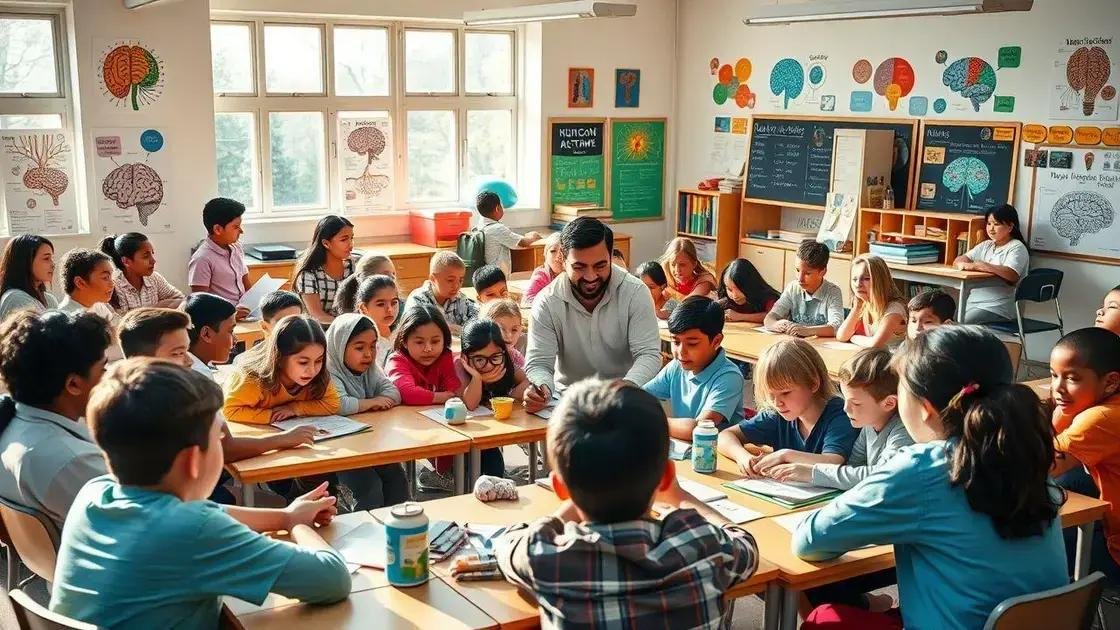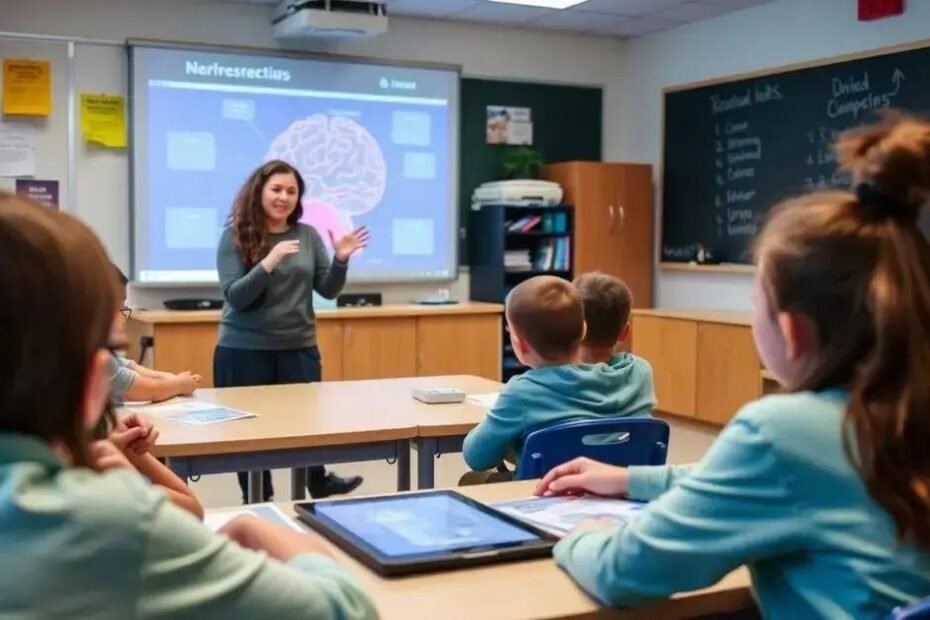Neuroeducation methods trends focus on integrating neuroscience and education to enhance learning through personalized strategies, technology, and social-emotional learning, ultimately improving student engagement and academic success.
Neuroeducation methods trends are reshaping how we think about learning and teaching. Imagine applying insights from neuroscience to enhance educational practices. Curious how this affects students and educators? Let’s dive into the latest developments.
Understanding neuroeducation methods
Understanding neuroeducation methods is essential for improving how we teach and learn. These methods are grounded in neuroscience, aiming to make education more effective by incorporating brain research into educational practices. Let’s explore how these approaches work together.
The basics of neuroeducation
At its core, neuroeducation combines insights from neuroscience and educational psychology. This collaboration fosters a deeper understanding of how students learn. By applying these insights, educators can create tailored learning experiences that meet the needs of every student.
Key principles of neuroeducation
- Brain-based learning: Recognizes that engaging the brain enhances memory and understanding.
- Emotional connections: Suggests that learning is more effective when students are emotionally engaged.
- Active learning: Encourages students to take part in their learning process through interactive methods.
These principles reflect a shift toward a more holistic approach in education, focusing on the learner’s experience rather than traditional teaching methods. As educators comprehend these concepts, they can better adapt their strategies to suit how the brain naturally learns.
Another important aspect is the role of neuroplasticity. This concept highlights the brain’s ability to change and adapt throughout a person’s life. Understanding this allows educators to instill a growth mindset in students, as they learn that their abilities can expand through effort and practice.
Moreover, multisensory learning is a key method that involves engaging multiple senses during the learning process. This not only makes learning more enjoyable but also enhances retention and recall. By using techniques that stimulate sight, sound, and touch, we can create a rich classroom environment that taps into the brain’s natural learning processes.
As we delve deeper into neuroeducation methods, recognizing the unique learning styles of each student becomes critical. Individualizing instruction can significantly impact a student’s academic success.
Recent trends in neuroeducation
Recent trends in neuroeducation reflect a dynamic approach to learning, emphasizing the brain’s role in educational practices. By leveraging the latest neuroscience discoveries, educators are better equipped to meet diverse student needs.
Technology integration
One significant trend is the increasing integration of technology in classrooms. Tools like interactive whiteboards and educational apps help engage students while facilitating a deeper understanding of material. This technological enhancement encourages collaborative learning, making education more interactive.
Focus on social-emotional learning
Another trend is a stronger focus on social-emotional learning (SEL). Educators are recognizing that students’ emotional health impacts their ability to learn. By incorporating SEL into their curricula, they help students develop resilience, empathy, and self-awareness, which are essential for academic success.
- Enhancing collaboration: Encouraging teamwork helps students improve their communication skills.
- Building resilience: Teaching coping strategies prepares students for challenges.
- Fostering empathy: Promoting understanding of others contributes to a positive classroom environment.
Moreover, research on brain-based learning strategies continues to influence classroom practices. Techniques such as spaced repetition and retrieval practice are becoming more common, as they align with how the brain processes and retains information. These strategies emphasize the importance of beyond memorization, enhancing comprehensive understanding.
Another growing area is the emphasis on personalized learning. Approaches that adapt to individual learning styles and paces allow students to take ownership of their education. This trend recognizes that every learner is unique and that instruction must be tailored accordingly for effective outcomes.
The impact of neuroscience on teaching

The impact of neuroscience on teaching is profound and transformative. Educators are increasingly using neuroscience research to improve their teaching methods. By understanding how the brain works, teachers can create more effective learning environments.
Enhanced understanding of learning processes
Neuroscience provides insights into the different ways students learn. For instance, recognizing that not all students process information the same way allows teachers to adapt their strategies accordingly. Teachers can use this knowledge to cater to various learning styles and paces, leading to better student engagement.
Application of brain-based strategies
Brain-based strategies focus on using techniques that align with how our brains naturally function. For example, implementing active learning methods encourages deeper understanding. Rather than relying solely on lectures, teachers can incorporate group discussions, hands-on activities, and technology to make lessons more engaging.
- Active participation: Students learn better when they actively engage with the material.
- Emotional connection: Learning is enhanced when students feel emotionally invested in their work.
- Multisensory approaches: Using multiple senses can improve retention and understanding of concepts.
Furthermore, understanding concepts like neuroplasticity empowers teachers to encourage a growth mindset in their students. Knowing that the brain can change and develop helps motivate students to embrace challenges and persist through difficulties.
The application of neuroscience also emphasizes the importance of social interactions in learning. Collaborative activities that promote teamwork and communication enhance relationships among students, which can lead to a more positive classroom atmosphere. This social component is essential, as it fosters community and support among learners.
Practical applications of neuroeducation
Practical applications of neuroeducation bring neuroscience theories into real-world classroom settings. These applications focus on enhancing learning by aligning teaching strategies with how the brain naturally functions.
Implementing active learning techniques
One powerful application is the use of active learning techniques. Instead of traditional lectures, teachers encourage students to participate actively in their learning process. Methods such as group work, discussions, and hands-on activities keep students engaged and help reinforce concepts.
Utilizing technology to support learning
Another practical application involves integrating technology into lessons. Educational apps and interactive software can make learning more exciting. Tools like virtual simulations give students valuable experiences related to their studies, enhancing understanding of complex topics.
- Gamification: Using game elements can motivate students and make learning fun.
- Multimedia resources: Videos and podcasts can cater to different learning styles.
- Online collaboration tools: Platforms that allow collaborative work increase student engagement.
In addition, incorporating mindfulness practices can lead to improved focus and emotional regulation among students. Techniques such as deep breathing and brief meditation breaks help create a calm environment that enhances learning.
Furthermore, setting up a classroom environment that reflects neuroscience principles is essential. When classrooms are well-organized and comfortable, they encourage a positive atmosphere. Features like flexible seating arrangements and areas for quiet reflection can significantly impact how students learn.
Another approach is to tailor instruction based on brain research regarding memory and retention. For instance, using spaced repetition can help students retain information more effectively. This method involves revisiting topics over specific intervals, promoting long-term memory storage.
Future predictions for neuroeducation strategies
Future predictions for neuroeducation strategies suggest a shift toward more personalized and technology-enhanced learning methods. As our understanding of the brain deepens, educational practices will continue to evolve to meet the needs of every learner.
Increased use of artificial intelligence
One significant trend is the integration of artificial intelligence in education. AI can analyze student data to create customized learning experiences tailored to individual strengths and weaknesses. This means lessons can become more relevant and engaging for each student.
Blended learning environments
Expect to see more blended learning environments where traditional teaching methods combine with online education. This approach allows students to learn at their own pace while still benefiting from direct teacher interaction. Blended learning supports the idea that different students thrive in varied settings.
- Flexible schedules: Students can choose when and where they learn, promoting autonomy.
- Access to diverse resources: Online platforms provide a wealth of information and materials.
- Scalable instruction: Teachers can reach a larger number of students effectively.
Moreover, research on neuroplasticity will continue to shape educational approaches. Understanding that the brain can grow and adapt will encourage strategies that foster resilience and adaptability in students. Teachers may focus even more on motivating students to embrace challenges, viewing failures as opportunities for growth.
Social-emotional learning will also play a larger role in future predictions. As schools recognize the importance of emotional well-being, educators will incorporate SEL strategies into their curricula. Collaborative projects may increase, allowing students to work together while developing crucial interpersonal skills.
Finally, expect a greater emphasis on mindfulness and mental health within educational settings. Schools may implement programs that promote mental clarity and well-being, resulting in environments conducive to learning. By addressing mental health, students will feel more supported and engaged in their education.
FAQ – Frequently Asked Questions about Neuroeducation Strategies
What is neuroeducation?
Neuroeducation combines neuroscience and education to enhance teaching and learning processes.
How does technology play a role in neuroeducation?
Technology aids in creating personalized learning experiences and engages students through interactive methods.
Why is social-emotional learning important in education?
Social-emotional learning helps students develop critical life skills, improving their emotional well-being and academic performance.
What is the significance of understanding neuroplasticity in education?
Understanding neuroplasticity encourages a growth mindset, showing students that their abilities can improve with effort and practice.

